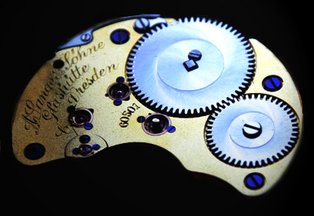Dreiviertel-Platine: Unterschied zwischen den Versionen
Zur Navigation springen
Zur Suche springen
Keine Bearbeitungszusammenfassung |
Keine Bearbeitungszusammenfassung |
||
| Zeile 2: | Zeile 2: | ||
|[[Dreiviertel-Platine]] | |[[Dreiviertel-Platine]] | ||
Um [[1864]] entwickelte [[Lange, Ferdinand Adolph (18.02.1815 - 03.12.1875)|Ferdinand Adolph Lange]] das legendäre klassische Dreiviertelplatinen-Kaliber für | Um [[1864]] entwickelte [[Lange, Ferdinand Adolph (18.02.1815 - 03.12.1875)|Ferdinand Adolph Lange]] in [[Glashütte]] das legendäre klassische Dreiviertelplatinen-[[Kaliber]] für [[Taschenuhr]]en. Die [[Platine]] überdeckt ca. drei Viertel des Werkes. [[Federhaus]], [[Kronrad]] und das gesamte [[Räderwerk]] sind darin gelagert. Die Lagerung der [[Unruh]] und des [[Anker|Ankers]] befinden sich in einem [[Kloben]]. | ||
The three-quarter plate was introduced in Glashütte by Adolph Lange in 1864. Since then, it has been a typical feature of Lange watches. It accommodates the counter-bearings of the going train and enhances the stability of the movement. | |||
Engl.: | |||
:The three-quarter plate was introduced in [[Glashütte]] by Adolph Lange in 1864. Since then, it has been a typical feature of Lange watches. It accommodates the counter-bearings of the going train and enhances the stability of the movement. | |||
== Literatur == | == Literatur == | ||
Version vom 12. Januar 2008, 11:38 Uhr
| Dreiviertel-Platine
Um 1864 entwickelte Ferdinand Adolph Lange in Glashütte das legendäre klassische Dreiviertelplatinen-Kaliber für Taschenuhren. Die Platine überdeckt ca. drei Viertel des Werkes. Federhaus, Kronrad und das gesamte Räderwerk sind darin gelagert. Die Lagerung der Unruh und des Ankers befinden sich in einem Kloben.
Literatur |
 | ||||||||||||||||||||||||
| |||||||||||||||||||||||||